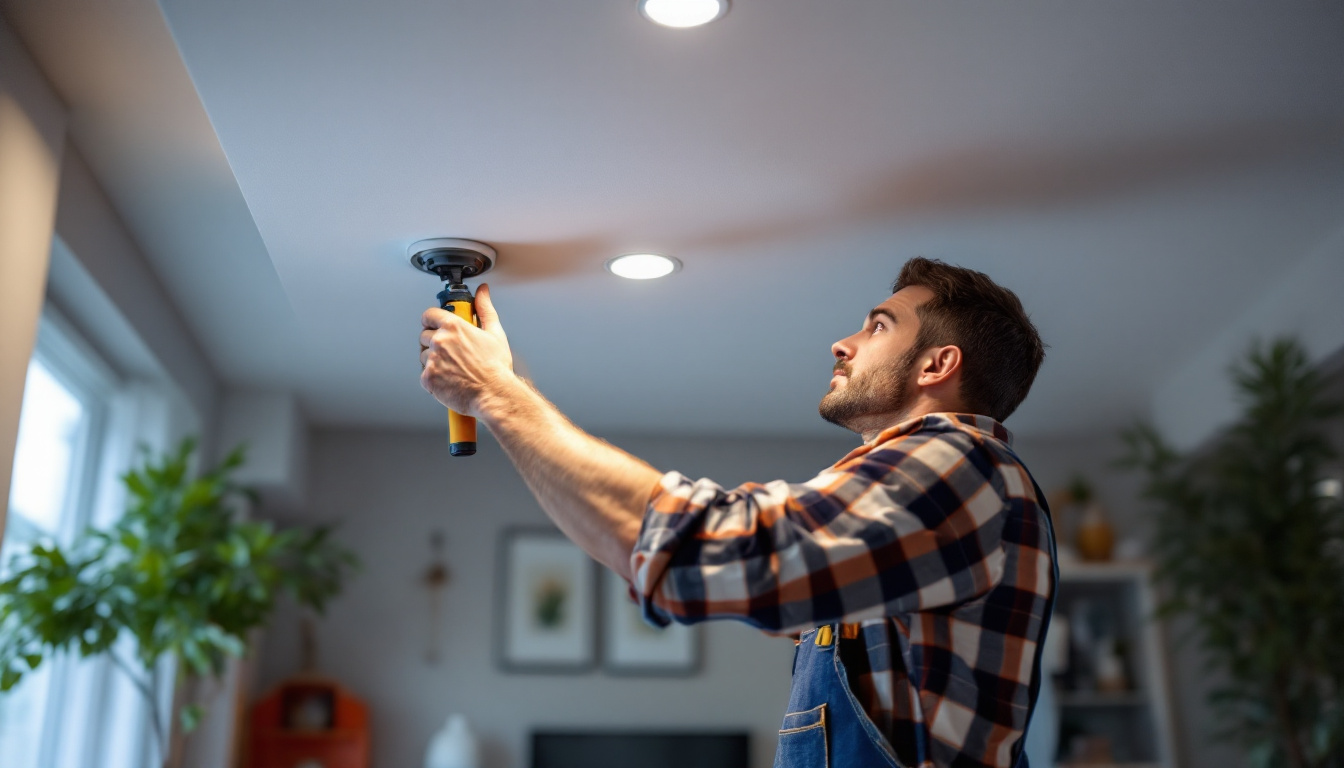
As the demand for modern and efficient lighting solutions rises, recessed lighting has become a popular choice among homeowners and commercial property managers alike. However, when it comes to renovations involving recessed lighting, there are several pitfalls that lighting contractors should be aware of. This guide aims to highlight common mistakes made during recessed lighting renovations and provide actionable insights to help contractors deliver exceptional results.
Before diving into the common mistakes, it is essential for lighting contractors to have a solid understanding of recessed lighting. This type of lighting is installed into the ceiling, providing a sleek and unobtrusive look. It can be used for various applications, including ambient lighting, task lighting, and accent lighting. The versatility of recessed lighting makes it an attractive option for many renovation projects. It seamlessly integrates into the architecture of a room, allowing for a clean and modern aesthetic that can elevate the overall design of both residential and commercial spaces.
However, the installation process requires careful planning and execution. Factors such as the type of fixtures, the layout of the space, and the intended use of the lighting must all be considered to ensure a successful outcome. Additionally, understanding the different types of bulbs available—such as LED, halogen, or incandescent—can significantly impact energy efficiency and the quality of light produced. Choosing the right bulb not only affects the ambiance but also contributes to the longevity and maintenance of the lighting system.
There are several types of recessed lighting fixtures available, each designed for specific purposes. The most common types include:
Furthermore, there are also specialized fixtures such as shower-rated recessed lights, which are designed to withstand moisture and humidity, making them suitable for bathrooms. Another option is the IC-rated fixtures, which are safe to install in insulated ceilings, ensuring that heat generated by the bulbs does not pose a fire hazard. Understanding these variations can help contractors and homeowners make informed decisions that align with their specific lighting needs.
Proper planning is crucial when designing a recessed lighting layout. Factors such as the height of the ceiling, the size of the room, and the function of the space should inform the placement of fixtures. A well-thought-out layout not only enhances the aesthetic appeal but also ensures effective illumination. For instance, in a kitchen, task lighting should be strategically placed over work areas like countertops and islands, while ambient lighting can be spread throughout the room to create a warm and inviting atmosphere.
Additionally, the spacing between fixtures is another critical consideration. A general rule of thumb is to place recessed lights approximately 4 to 6 feet apart, depending on the wattage of the bulbs and the height of the ceiling. This spacing helps to avoid dark spots and ensures even distribution of light. Incorporating dimmer switches can also provide flexibility, allowing users to adjust the brightness according to their needs and preferences, further enhancing the functionality of the recessed lighting system.
Even seasoned lighting contractors can fall prey to common mistakes during recessed lighting renovations. Awareness of these pitfalls can help avoid costly errors and ensure client satisfaction.
One of the most significant mistakes is failing to plan the lighting design thoroughly. Without a clear vision, contractors may end up with uneven lighting, shadows, or overly bright spots. It is essential to create a lighting plan that considers the room’s purpose, the desired mood, and the architectural features.
Utilizing design software or tools can aid in visualizing the layout and determining the optimal placement of fixtures. Engaging with clients during the planning process can also provide valuable insights into their preferences and expectations.
Ceiling height plays a crucial role in the effectiveness of recessed lighting. Installing fixtures too close to the ceiling can result in harsh shadows, while those placed too low may create an overwhelming effect. It is vital to consider the height and volume of the space when determining the placement and type of fixtures.
Additionally, in rooms with sloped ceilings or architectural features, careful consideration must be given to how light will be distributed. This requires a keen understanding of how light interacts with different surfaces and angles.
Electrical planning is another area where mistakes can occur. Failing to account for the electrical load can lead to circuit overloads, flickering lights, or even fire hazards. It is essential to calculate the total wattage of the fixtures and ensure that the circuit can handle the load.
Moreover, using the correct gauge of wiring and ensuring proper connections are crucial for safety and functionality. Consulting with an electrician during the planning phase can help mitigate these risks.
The selection of recessed lighting fixtures is a critical aspect of any renovation project. The right fixtures not only enhance the aesthetic appeal but also improve functionality. Here are some common mistakes to avoid when choosing fixtures:
Different spaces require different types of lighting. For instance, task lighting in a kitchen may require brighter, focused light, while ambient lighting in a living room may call for softer illumination. Failing to consider the specific needs of each space can lead to unsatisfactory results.
Contractors should engage with clients to understand their needs and recommend fixtures that align with those requirements. This collaborative approach ensures that the final outcome meets or exceeds expectations.
In an effort to cut costs, some contractors may opt for lower-quality fixtures. However, this can lead to issues such as poor light output, short lifespan, and increased maintenance costs. Investing in high-quality fixtures may have a higher upfront cost but can save money in the long run through reduced replacements and repairs.
It is advisable to choose fixtures from reputable manufacturers that offer warranties and support. This not only enhances the quality of the installation but also builds trust with clients.
The trim style of recessed fixtures can significantly impact the overall appearance of the lighting. Failing to match the trim style with the room’s decor can create a disjointed look. There are various trim styles available, including baffle, reflector, and adjustable trims, each serving different aesthetic and functional purposes.
Contractors should consider the overall design theme of the space and select trims that complement the existing decor. This attention to detail can elevate the quality of the renovation and enhance client satisfaction.
Proper installation techniques are vital for the success of recessed lighting renovations. Mistakes during installation can lead to issues such as uneven lighting, fixture misalignment, and safety hazards. Here are some common installation mistakes to avoid:
Even with a well-planned layout, incorrect placement of fixtures can occur during installation. It is crucial to double-check measurements and ensure that fixtures are aligned according to the design plan. Using templates or guides can help maintain consistency and accuracy during installation.
Additionally, contractors should consider the beam spread of the fixtures. The distance between fixtures should be calculated based on the type of bulb used and the desired lighting effect.
Inadequate insulation and airflow can lead to energy inefficiency and potential fire hazards. When installing recessed lighting, it is essential to use IC-rated fixtures in insulated ceilings to prevent overheating. Properly sealing any gaps around the fixtures can also help maintain energy efficiency.
Contractors should be aware of local building codes and regulations regarding insulation and airflow to ensure compliance and safety.
After installation, it is crucial to test the lighting and make necessary adjustments. Skipping this step can result in an unsatisfactory outcome, leading to client dissatisfaction. Contractors should take the time to assess the lighting from different angles and make adjustments as needed to achieve the desired effect.
Encouraging clients to provide feedback during this phase can also help identify any issues that may need addressing before the project is considered complete.
The work does not end once the fixtures are installed. There are several post-installation considerations that contractors should keep in mind to ensure long-term satisfaction and functionality.
Clients may not be familiar with how to operate or maintain their new recessed lighting. Providing education on the use of dimmers, timers, and other controls can enhance their experience and satisfaction. Additionally, informing clients about the types of bulbs to use and maintenance tips can prolong the lifespan of the fixtures.
Offering a brief tutorial or providing written instructions can empower clients to make the most of their new lighting system.
Even with careful planning and execution, issues may arise after installation. Contractors should remain available to address any concerns or questions that clients may have. Promptly addressing issues can help maintain a positive relationship and encourage referrals for future projects.
Establishing a follow-up schedule to check in with clients can also demonstrate commitment to quality service and client satisfaction.
Feedback from clients is invaluable for improving future projects. Contractors should actively seek input on the installation process, the quality of the fixtures, and the overall satisfaction with the lighting. This information can help identify areas for improvement and enhance the contractor’s reputation.
Utilizing client testimonials in marketing materials can also serve as a powerful tool for attracting new business.
Recessed lighting renovations can significantly enhance the aesthetic and functionality of a space when done correctly. By avoiding common mistakes and adhering to best practices, lighting contractors can deliver exceptional results that satisfy clients and stand the test of time. Understanding the basics of recessed lighting, planning effectively, choosing quality fixtures, employing proper installation techniques, and addressing post-installation considerations are all crucial steps in ensuring a successful renovation project.
By staying informed and continually refining skills, lighting contractors can navigate the complexities of recessed lighting renovations with confidence, ultimately leading to satisfied clients and a thriving business.
Ready to elevate your recessed lighting projects with the highest quality fixtures on the market? Look no further than LumenWholesale. Our spec-grade lighting products are designed to meet the needs of the most discerning contractors, offering unbeatable wholesale prices and the convenience of bulk buying without the hassle. Say goodbye to inflated markups and hidden fees, and hello to reliable, high-performance lighting that will impress your clients and enhance your craftsmanship. With free shipping on all orders, LumenWholesale is your go-to source for lighting that combines quality, affordability, and convenience. Don’t compromise on your lighting supplies—choose LumenWholesale for the best value in wholesale lighting. Wholesale Lighting at the Best Value.

Discover essential insights and expert advice from lighting contractors on maximizing the efficiency and aesthetics of Mhl lamps.

Discover how overhead lighting fixtures can provide a competitive edge for lighting contractors.

Discover the ultimate guide for lighting contractors on flat LED lights.

Discover how to enhance the longevity and efficiency of your lighting projects with the right tanning bed ballast.